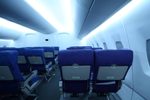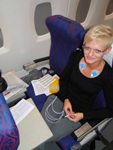Osram, Bergische Universitt Wuppertal, the Fraunhofer Institute for Building Physics, Airbus, and Diehl Aerospace partnered to study how chronobiologically-adapted LED lighting can enhance passenger wellbeing on long-distance flights.‘

Cold-white lighting in the morning
Adaptive solid-state lighting (SSL) scenarios in which the color and brightness of lighting is varied during long-distance overnight flights results in passengers that sleep better and are more alert upon arrival. Partners Osram, Bergische Universitt Wuppertal, the Fraunhofer Institute for Building Physics, Airbus, and Diehl Aerospace reached the conclusion of improved wellbeing attributed to chronobiologically-adapted LED lighting after tests in a model aircraft cabin over a period of six days.
The partners built the model cabin that was equipped like a real plane at the Diehl facility in Nuremberg, Germany. The team put 32 test subjects through three overnight flights using realistic scenarios common in long-distance routes.
The team found that at the start of an overnight flight that warm-white light helps to stimulate melatonin production and increases passenger relaxation. Indeed, the warm lighting was noted to reduce the heart rate in the test subjects and yield "medically measureable improvement" in sleep patterns.

Physiological and psychological monitoring
The study further revealed that blue-rich cold light in the morning increased alertness. In part, the cooler light suppresses melatonin production. The result for passengers is better productivity or more enjoyment over the course of the arrival day after a long trip.
Both psychological and physiological reactions were analyzed in the test subjects. The team used medical instruments to capture data such as heart rate and ECG measurements. That data was analyzed alongside assessments completed by the test subjects and by observers of the tests. The team believes that the work can be applied using intelligent SSL systems in aircraft to help minimize passenger jet lag by maintaining normal circadian rhythms.





